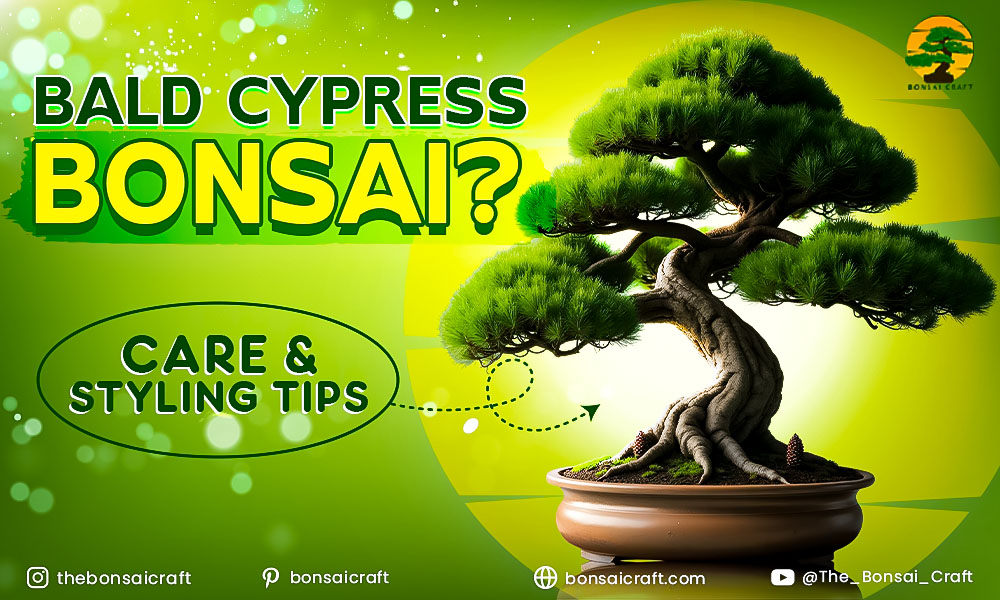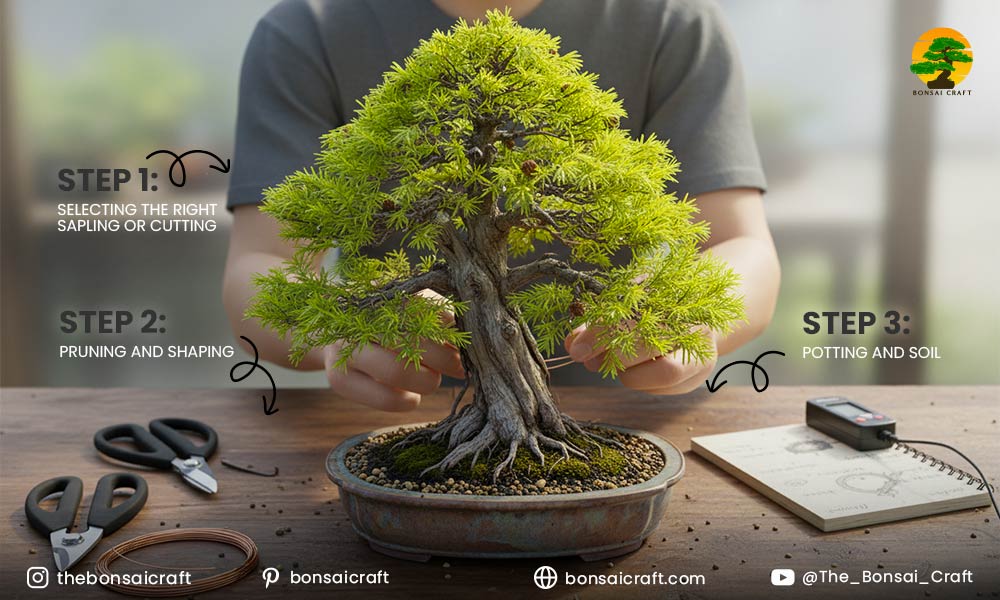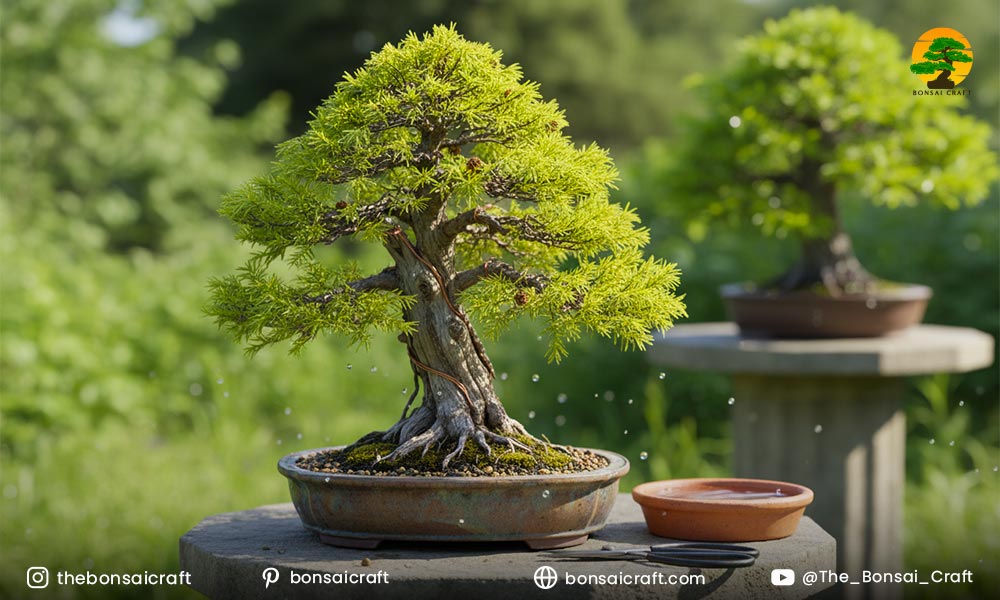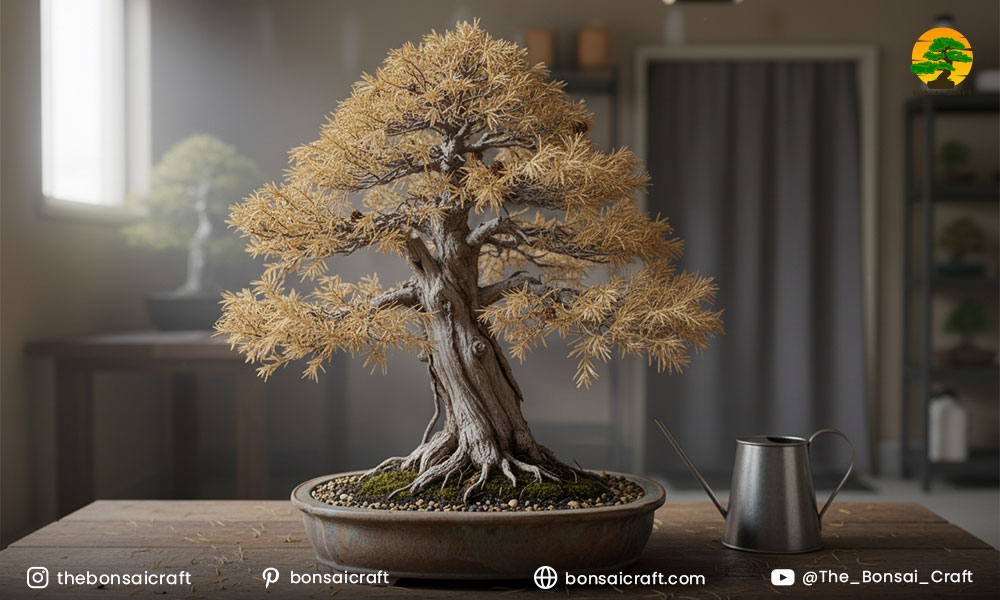
Mature Bald Cypress Bonsai trees (Taxodium distichum) are striking specimens of unparalleled beauty and balmy resilience. Given that they are swamp trees, they flourish in wet, swampy conditions, which aids in bonsai cultivation. This tree is visually stunning and desirable for bonsai cultivators because of its graceful, needle-like foliage and its fall golden coloring. This guide will provide you with basic care pointers as well as grow and shape your bonsai tree using advanced techniques. Mastering Bald Cypress Bonsai care, no matter your skill level, will ensure you reap the rewards.
What Is a Bald Cypress Bonsai?
A Bald Cypress Bonsai is a type of directly cutterable, deciduous, coniferous evergreen originating from the southern parts of the US, where it was habitually found in swamps or wetlands. Unlike other evergreens, this species sheds its needle-like leaves in the fall. The Bald Cypress Bonsai has an affinity for moist conditions, which is why it’s often colloquially referred to as a ‘swamp tree. It thrives even in standing water. Being a Cypress bonsai lover, you will have an easy time trying to replicate a swamp-like aesthetic often sought among bonsai enthusiasts due to its semi-aquatic nature.
This tree is known for its high resilience, for being adaptable to a variety of soil conditions, and for being aesthetically pleasing. While often criticized for being unsightly, its striking knees, a part of the uniquely dry root system, when exposed to wetland environments, become visually interesting. Due to its diverse characteristics, the swamp tree is becoming a favorite among bonsai enthusiasts as it combines versatility and beauty.

How to Make a Bald Cypress Bonsai
The journey to make a Bald Cypress Bonsai from a seedling is a fascinating adventure. To ensure proper development, you can choose between a flat top Bald Cypress Bonsai or a traditional styled the swamp tree, but there are several steps to follow.
Step 1: Selecting the Right Sapling or Cutting
The process to make a Bald Cypress Bonsai starts with finding the correct sapling or cutting. Aim for a Bald Cypress Bonsai Tree with a healthy structure that has a strong root system. If you are just beginning, young trees or seedlings are a good place to start, and so is growing from a cutting if you want a more hands-on approach.
Step 2: Pruning and Shaping
Choosing the right tree is just the first step. Begin by pruning the tree so that it grows in the direction that you want, especially the trunk and branches. To ensure the desired symmetry and proportion, you can use bonsai wire to shape the tree. For a flat top bald cypress bonsai, canopy pruning to a rounded shape is also important.
Regular pruning helps to maintain and shape your Bald Cypress Bonsai and keep it compact. Encourage growth on the main trunk by cutting off excess branches and be sure to remove any dead branches to help new growth flourish.
Step 3: Potting and Soil
The next step is to find a suitable pot for your Bald Cypress Bonsai. Choose a shallow pot that drains well to prevent water from accumulating and damaging the roots. Although the Bald Cypress Bonsai thrives in wet conditions, the soil needs to be well-draining and able to retain moisture. Thoroughly emptying the accumulated soil and doing a root prune every 2-3 years helps to make sure the roots have plenty of space to grow and helps prevent overcrowding. During the repotting stage, make sure to trim the roots to promote healthy growth.

Bald Cypress Bonsai Care: Essential Tips
Bald Cypress Bonsai care focuses on three main elements: keeping the tree well watered, getting enough sunlight, and pruning the tree. Let’s discuss how to care for your Cypress Bonsai in more detail:
Watering
Proper care of the swamp tree includes paying special attention to the moisture level of the soil. As a swamp tree, Bald Cypress needs a lot of moisture to thrive. Its potting soil should be moist in spring and summer, and watered regularly but not overly soggy.
From a more naturalistic approach, the swamp tree can also be grown directly in water. Placing a shallow dish filled with water can recreate the tree’s native swampy growing conditions. Make sure the water level never rises above the roots for so long that the tree roots begin to rot.
Sunlight
Having the the swamp tree placed fully in the sun is essential in caring for the tree. Make sure your tree is positioned where it can receive more than six hours of direct sunlight everyday. While some partial shade can be tolerated, the tree grows best in brightly lit areas. Should you be growing the tree indoors, consider investing in a grow light to use in supplementing natural light.
Pruning
Regular pruning is essential for the health and the aesthetic appeal of your Bald Cypress Bonsai. Regular pruning of dead or damaged branches helps to freshen new growth and helps the bonsai keep its shape. Cypress tree care also involves the pruning of overgrown branches that may be interfering with the main trunk. Further, you have the option of wiring the tree to guide the trunk and branches into the desired shape as the tree develops. During pruning, it is essential to restrict each trim to a third of the overall tree size to avoid shocking the tree.
Bald Cypress Bonsai in Water: Growing in Aquatic Environments
An interesting feature of Bald Cypress Bonsai is their ability to grow in water. In the wild, this tree is found in swampy areas where it is common for the tree to be partially submerged in water. In order to provide an optimal environment, you can grow your Bald Cypress Bonsai in water.
To maintain your tri, place it into a shallow container filled with water. The container should be shallow enough to keep the trunk dry, while the roots are submerged. Make sure to maintain water levels for the best growth. This method also helps provide better humidity, which is beneficial for growth, especially when grown indoors.
Make sure to change the water every few days to avoid stagnation and algae growth. This guarantees that the roots receive oxygen. Keeping your Bald Cypress Bonsai in water not only provides aesthetic appeal; it lets you simulate the tree’s natural swamp habitat in your home.

Bald Cypress Bonsai Winter Care
As a deciduous tree, the swamp tree sheds its needles in winter, entering a dormant phase. Winter care is crucial to ensuring the tree’s health and longevity. Here are some important tips to follow during the colder months:
Protect From Freezing
The Bald Cypress Bonsai, although tolerant to the cold, is susceptible to freezing temperatures. If you live in an area with severe cold winters, is important to insulate this tree from the cold. Relocating the tree to frost-free zones, like a cool basement or an unheated garage, is ideal.
Watering During Winter
Even though the Bald Cypress Bonsai is dormant in winter, the tree still requires water. Reducing the amount of water provided is recommended, but it must not be completely withheld. Monitoring the soil is a must to ensure it doesn’t completely dry, but overwatering must be avoided.
Avoid Fertilizing
As with all trees, winter is a dormant period for growing, so do not fertilize your Bald Cypress Bonsai. Only resume fertilizing in spring, as the new growth appears.
When to Repot Bald Cypress Bonsai
Cypress trees have particular care requirements, and repotting is one of the most critical. The Bald Bonsai requires repotting every 2-3 years with a dose of fresh soil. This is best done in early spring before the growth period. The Bonsai will continue to thrive while having time to adjust to the soil and nutrients available.
Repotting Process
During repotting, carefully lift the seedling from its container and check the roots. Prune any dead roots as well as excessively long roots. Be sure not to hurt the healthy roots. It is best to place the seedling in a fresh container that is incrementally larger than the last. Fill the new pot with well-draining bonsai soil. This practice helps freshen the soil, decrease the chances of root rot, and allows the Bonsai tree to flourish.
Bald Cypress Bonsai Forest: A Beautiful Display
With Bald Cypress Bonsais, exhibiting multiple trees in one container is a unique forest style. It fully captures the tree’s essence and beauty while creating a breathtaking display.
Arranging the Trees
To design a Cypress Bonsai forest, two or more trees should be planted in a wide, shallow container. Position the trees in layers, with the taller trees in the back and shorter ones in the front. This enhances the depth and dimension, rendering the forest more lifelike.
Maintaining the Forest
To achieve a balanced forest composition, prune the trees to ensure they grow in a staggered fashion. Eventually, the trees will grow together to achieve a unified forest composition. This Bonsai collection showcases a serene glimpse of wetlands, and the Bald Bonsai Forest is a wonderful centerpiece for that.

Leyland Cypress Bonsai vs Bald Cypress Bonsai: Key Differences
While both the Leyland Cypress Bonsai and Bald Cypress Bonsai are excellent choices for bonsai lovers, they have distinct differences:
Leaf Structure
With the Leyland Cypress Bonsai, the foliage will be preserved for the entire year. Bald Cypress Bonsai, in contrast, is a deciduous tree and will lose its needles in the fall. This characteristic is great for people who prefer seasonal changes.
Watering Needs
The Bald Cypress Bonsai flourishes in wet environments and can even be cultivated in standing water. The Leyland Cypress Bonsai is less tolerant of moisture and prefers drier soils.
Growth Rate
If you want a faster-growing Bonsai, then the Leyland Cypress Bonsai is the best option for you, as it grows faster than the Bald Cypress Bonsai. The Bald Cypress Bonsai is ideal for someone who prefers a bonsai that can be physically shaped and molded in a slower fashion.
Conclusion
Caring for a Bald Cypress Bonsai offers a rewarding experience, especially with the tree’s unique ability to thrive in both water and soil. From creating a Cypress Bonsai forest to maintaining a single tree, this species offers endless possibilities for bonsai enthusiasts. By following the care tips outlined in this guide—such as ensuring proper watering, sunlight, and pruning—you can enjoy the beauty and elegance of your Bald Cypress Bonsai for years to come.
Whether you grow it in water, shape it into a flat top cypress bonsai, or create a beautiful forest display, the Bald Cypress Bonsai is a tree that adds both character and tranquility to any bonsai collection.
FAQs
How Do You Water a Bald Cypress Bonsai?
As a general rule, Bald Cypress Bonsai should be watered to maintain a constant level of moisture in the soil. The swamp tree should be watered to maintain a constant level of moisture in the soil, particularly in the active growing season. The soil should never dry out completely, but the pot must provide good drainage to avoid root rot. During the winter, water less but keep the soil moist.
Can Bald Cypress Bonsai Survive Indoors?
Bald Cypress Bonsai can survive indoors if there is enough light, especially six hours a day. Misting the leaves or using a humidity tray can help maintain the required humidity. The bonsai should be placed in a cool area with moderate temperatures, away from heat sources, but the tree must be kept out of the direct sun.
When Should You Prune a Bald Cypress Bonsai?
Bald Cypress Bonsai should be pruned a few times a year, ideally in the spring or summer. The tree should be shaped to remove dead or damaged branches and to avoid overcrowded branches, to maintain shape. Do not prune in winter while the tree is dormant.
Why Are the Leaves of My Bald Cypress Bonsai Turning Brown?
Bonsai Bald Cypress leaves turning brown could be a result of overwatering, underwatering, environmental changes, or even temperature shifts. Make sure the bonsai is not exposed to extreme temperatures, gets sunlight, and is watered properly. Always check and care for pest control too.
